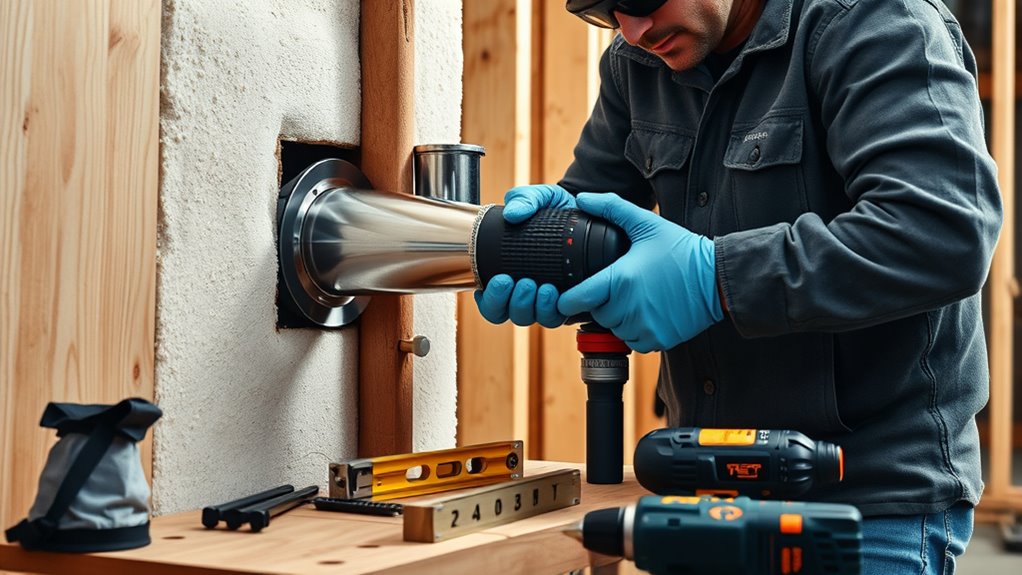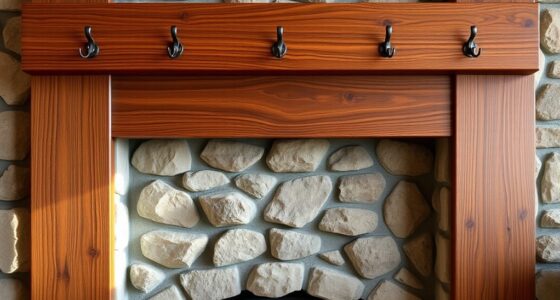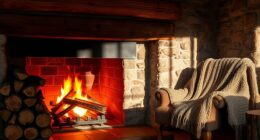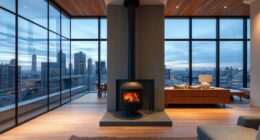To install a through-the-wall chimney safely, first verify you check local building codes and plan for proper clearance from windows or combustible materials. Reinforce the wall opening with suitable framing to maintain structural integrity and prevent fire hazards. Carefully mark and cut the wall, avoiding wiring or plumbing, then insert and seal the chimney pipe with high-temperature sealant. Regular inspection and adherence to safety standards will keep your system secure—continue to explore the full installation process for detailed guidance.
Key Takeaways
- Ensure proper chimney clearance from windows, doors, and combustible materials according to local building codes.
- Reinforce exterior wall openings with suitable framing to maintain structural integrity during installation.
- Use appropriate tools to cut the wall carefully, avoiding damage to internal wiring or plumbing.
- Seal the wall opening with high-temperature, weatherproof sealant and ensure secure, level chimney connection.
- Follow safety guidelines, use fire-resistant materials, and conduct regular inspections for safe, code-compliant operation.
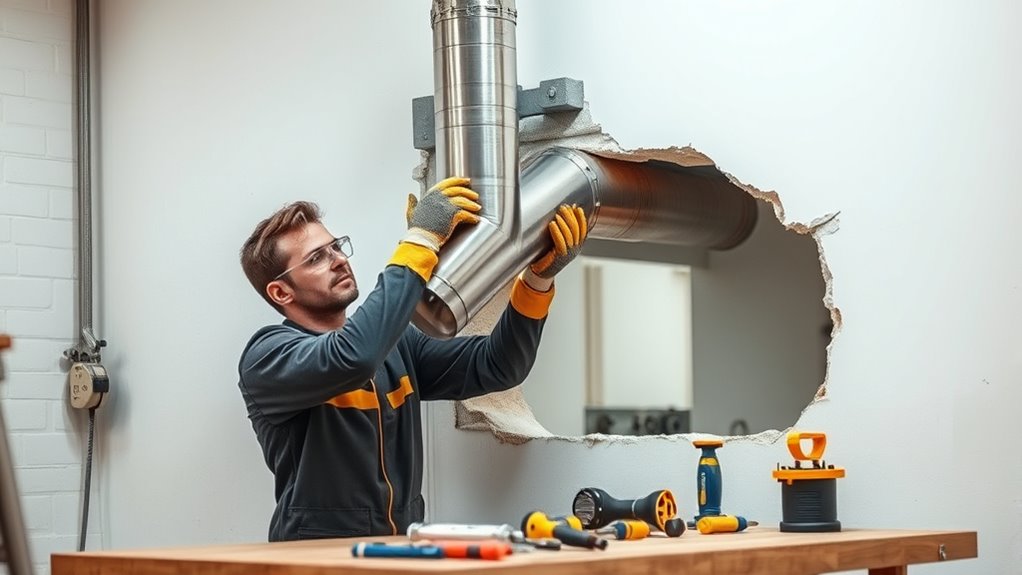
Installing a through-the-wall chimney can be a practical way to vent your fireplace or stove directly to the outside. This method provides efficient exhaust and helps keep your indoor air clean. However, before starting, you must consider chimney clearance—ensuring there’s enough space around the chimney pipe for safe operation and proper airflow. Check local building codes for minimum clearance distances from windows, doors, and combustible materials. Failing to maintain proper clearance can lead to fire hazards or inefficient venting, so measure carefully and plan your installation accordingly.
Ensure proper clearance around your through-the-wall chimney for safety and efficient venting.
Wall reinforcement is another critical aspect of installing a through-the-wall chimney. When you cut through the exterior wall, you compromise its structural integrity, especially if the wall is load-bearing. To prevent issues like wall sagging or collapse, reinforce the opening with appropriate framing materials such as steel or timber. This reinforcement provides a stable support for the chimney pipe and ensures the wall remains strong and safe. You may need to consult a structural engineer if you’re uncertain about the wall’s load-bearing capacity or if the wall is particularly thick or made of specialized materials.
When preparing for installation, start by marking the exact location for the chimney pipe, considering both clearance requirements and ease of access for maintenance. Cut through the exterior wall using proper tools, such as a reciprocating saw or hole saw, and be cautious to avoid damaging wiring or plumbing inside the wall. Once the opening is made, install a firestop or fire-resistant collar around the pipe to prevent heat transfer and improve safety. Insert the chimney pipe through the opening, ensuring it’s level and properly sealed to prevent leaks or drafts. Additionally, be aware that state tax implications for IRA withdrawals can influence your financial planning during retirement, so consider how your overall strategy aligns with your venting project. For added safety, it’s beneficial to select fire-resistant materials that meet local codes to enhance the durability and safety of your chimney system. Proper installation techniques are essential to ensure the system functions correctly and safely over time. Being aware of local building codes can help prevent costly modifications after installation.
As you assemble the system, double-check that all sections of the chimney are securely connected and aligned. Seal any gaps around the wall penetration with high-temperature, weatherproof sealant to keep out moisture and pests. Make sure the chimney extends sufficiently above the roofline to promote proper draft and prevent smoke from entering your home. Regularly inspect the clearance and reinforcement throughout the process—these are essential to maintain safety, prevent fire hazards, and ensure the longevity of your installation.
Frequently Asked Questions
Can I Install a Through-The-Wall Chimney Myself?
Yes, you can install a through-the-wall chimney yourself, but it’s not recommended without proper experience. You need to carefully install the vent pipe, making sure it’s sealed and properly supported, and use chimney flashing to prevent leaks. Improper installation risks dangerous fumes and fire hazards. If you’re unsure, consult a professional to ensure safety and code compliance. Always prioritize safety when working with chimney systems.
What Permits Are Required for Chimney Installation?
They say “forewarned is forearmed,” so check with your local building department first. You’ll likely need permits for chimney installation, guaranteeing you meet building codes and maintain proper chimney clearance. These regulations prevent hazards and ensure safety. Always verify specific requirements in your area, as permits and codes can vary. Securing the right permits before starting keeps your project legal, safe, and smoothly on track.
How Do I Ensure Proper Insulation Around the Chimney?
You should focus on effective insulation techniques like using fire-resistant, weatherproof materials around the chimney to prevent heat loss and moisture intrusion. Seal all gaps with high-temperature, weatherproof caulking or insulation foam to guarantee a tight fit. Wrap the exterior with weatherproofing methods such as flashing and waterproof sealant to protect against the elements. Proper insulation and weatherproofing keep your chimney safe, efficient, and durable year-round.
What Materials Are Best for Weatherproofing the Chimney?
Did you know that using the right weatherproofing materials can extend your chimney’s lifespan by up to 50%? For effective weatherproofing, choose high-quality materials like stainless-steel or aluminum flashing, durable sealants, and chimney-specific sealants. These materials prevent water intrusion and damage. Apply chimney sealants around joints and flashing to create a watertight barrier. Regular maintenance with proper weatherproofing materials keeps your chimney safe and functional through all seasons.
How Often Should I Inspect and Maintain the Chimney?
You should inspect and maintain your chimney at least once a year. Regular chimney cleaning removes soot and debris, preventing fire hazards, while vent inspection guarantees proper airflow and detects any blockages or damage. After severe weather or heavy use, consider more frequent checks. Staying proactive helps avoid costly repairs and keeps your through-the-wall chimney functioning safely and efficiently.
Conclusion
Installing a through-the-wall chimney is a smart way to improve your home’s safety and efficiency. Just remember, proper installation reduces the risk of fire and carbon monoxide leaks. Did you know that improper chimney installation accounts for over 20% of residential fires annually? By following these steps carefully, you guarantee a safe, long-lasting venting system. Take your time, double-check your work, and enjoy the warmth and comfort of your home worry-free.

